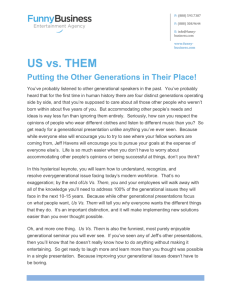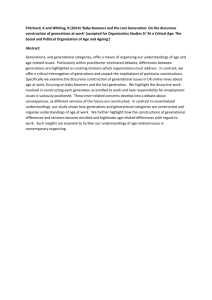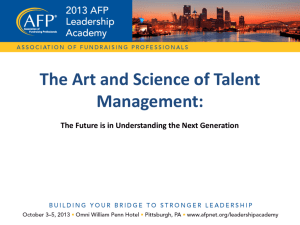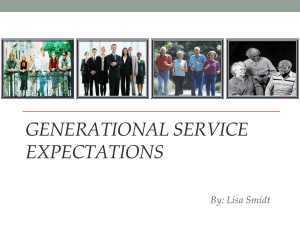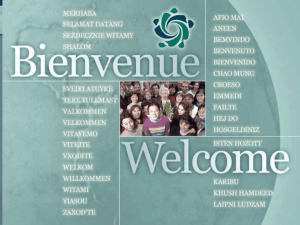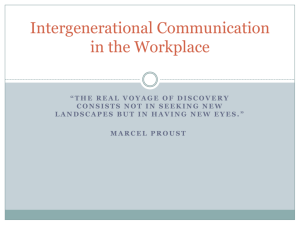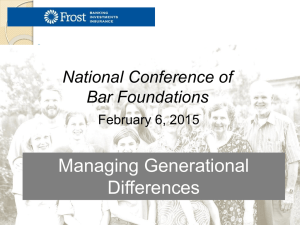48x36 Poster Template
advertisement
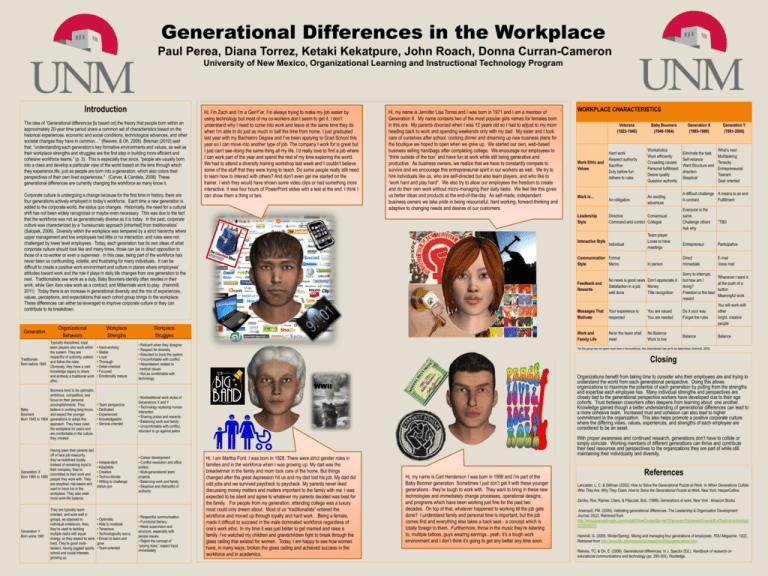
Generational Differences in the Workplace Paul Perea, Diana Torrez, Ketaki Kekatpure, John Roach, Donna Curran-Cameron University of New Mexico, Organizational Learning and Instructional Technology Program Introduction The idea of “Generational differences [is based on] the theory that people born within an approximately 20-year time period share a common set of characteristics based on the historical experiences, economic and social conditions, technological advances, and other societal changes they have in common…” (Reeves, & Oh, 2008) Birkman (2010) said that, “understanding each generation’s key formative environments and values, as well as their workplace strengths and struggles are the first step in building more efficient and cohesive workforce teams.” (p. 3). This is especially true since, "people are usually born into a class and develop a particular view of the world based on the lens through which they experience life, just as people are born into a generation, which also colors their perspectives of their own lived experiences." (Carver, & Candela, 2008) These generational differences are currently changing the workforce as many know it. Corporate culture is undergoing a change because for the first time in history, there are four generations actively employed in today’s workforce. Each time a new generation is added to the corporate world, the status quo changes. Historically, the need for a cultural shift has not been widely recognized or maybe even necessary. This was due to the fact that the workforce was not as generationally diverse as it is today. In the past, corporate culture was characterized by a “bureaucratic approach [inherited] from traditionalists” (Salopek, 2006). Diversity within the workplace was tempered by a strict hierarchy where upper management and line employees had little or no interaction, and rules were not challenged by lower level employees. Today, each generation has its own ideas of what corporate culture should look like and many times, those can be in direct opposition to those of a co-worker or even a supervisor. In this case, being part of the workforce has never been so confounding, volatile, and frustrating for many individuals. It can be difficult to create a positive work environment and culture in places where employees' attitudes toward work and the role it plays in daily life changes from one generation to the next. Traditionalists see work as a duty, Baby Boomers identity often resides in their work, while Gen Xers view work as a contract, and Millennials work to play. (Hammill, 2011) Today there is an increase in generational diversity and the mix of experiences, values, perceptions, and expectations that each cohort group brings to the workplace. These differences can either be leveraged to improve corporate culture or they can contribute to its breakdown. Generation Organizational Behaviors Traditionals Born before 1945 Typically disciplined, loyal team players who work within the system. They are respectful of authority, patient and follow the rules. Obviously, they have a vast knowledge legacy to share and embody a traditional work ethic. Boomers tend to be optimistic, ambitious, competitive, and focus on their personal accomplishments. They Baby believe in working long-hours Boomers and expect the younger Born 1945 to 1964 generations to adopt this approach. They have ruled the workplace for years and are comfortable in the culture they created. Having seen their parents laid off or face job insecurity, they’ve redefined loyalty. Instead of remaining loyal to their company, they’re Generation X committed to their work and Born 1965 to 1980 people they work with. They are skeptical, risk-takers and want to have fun in the workplace. They also seek more work-life balance. Generation Y Born since 1981 They are typically teamoriented, and work well in groups, as opposed to individual endeavors. Also, they’re used to tackling multiple tasks with equal energy, so they expect to work hard. They’re good multitaskers, having juggled sports, school and social interests growing up. Workplace Strengths • Hard-working • Stable • Loyal • Thorough • Detail oriented • Focused • Emotionally mature Hi, I’m Zach and I’m a GenY’er. I’m always trying to make my job easier by using technology but most of my co-workers don’t seem to get it. I don’t understand why I need to come into work and leave at the same time they do when I’m able to do just as much in half the time from home. I just graduated last year with my Bachelors Degree and I’ve been applying to Grad School this year so I can move into another type of job. The company I work for is great but I just can’t see doing the same thing all my life. I’d really love to find a job where I can work part of the year and spend the rest of my time exploring the world. We had to attend a diversity training workshop last week and I couldn’t believe some of the stuff that they were trying to teach. Do some people really still need to learn how to interact with others? And don’t even get me started on the trainer. I wish they would have shown some video clips or had something more interactive. It was four hours of PowerPoint slides with a test at the end. I think I can show them a thing or two. Hi, my name is Jennifer Lisa Torres and I was born in 1971 and I am a member of Generation X. My name contains two of the most popular girls names for females born in this era. My parents divorced when I was 12 years old so I had to adjust to my mom heading back to work and spending weekends only with my dad. My sister and I took care of ourselves after school, cooking dinner and dreaming up new business plans for the boutique we hoped to open when we grew up. We started our own, web-based business selling handbags after completing college. We encourage our employees to “think outside of the box” and have fun at work while still being generative and productive. As business owners, we realize that we have to constantly compete to survive and we encourage this entrepreneurial spirit in our workers as well. We try to hire individuals like us, who are self-directed but also team players, and who like to “work hard and play hard”. We also try to allow our employees the freedom to create and do their own work without micro-managing their daily tasks. We feel like this gives us better ideas and products at the end-of-the-day. As self-made, independent business owners we take pride in being resourceful, hard working, forward-thinking and adaptive to changing needs and desires of our customers. • Independent • Adaptable • Creative • Techno-literate • Willing to challenge status quo • Optimistic • Able to multitask • Tenacious • Technologically savvy • Driven to learn and grow • Team-oriented Work is… Hard work Respect authority Sacrifice Duty before fun Adhere to rules An obligation Feedback and Rewards Baby Boomers (1946-1964) Workaholics Work efficiently Crusading causes Personal fulfillment Desire quality Question authority An exciting adventure Directive Consensual Command-and-control Collegial Individual Communication Formal Style Memo • Reticent when they disagree • Respect for diversity • Reluctant to buck the system • Uncomfortable with conflict • Absenteeism related to medical issues • Not as comfortable with technology Team player Loves to have meetings In person No news is good news Don’t appreciate it Satisfaction in a job Money well done Title recognition Generation X (1965-1980) Generation Y (1981-2000) What’s next Eliminate the task Multitasking Self-reliance Tenacity Want Structure and Entrepreneurial direction Tolerant Skeptical Goal oriented A difficult challenge A means to an end A contract Fulfillment Everyone is the same Challenge others Ask why *TBD Entrepreneur Participative Direct Immediate E-mail Voice mail Sorry to interrupt, but how am I doing? Freedom is the best reward Whenever I want it, at the push of a button Meaningful work Messages That Motivate Your experience is respected You are valued You are needed Do it your way Forget the rules You will work with other bright, creative people Work and Family Life Ne’er the twain shall meet No Balance Work to live Balance Balance *As this group has not spent much time in the workforce, this characteristic has yet to be determined. (Hammill, 2005) Closing Organizations benefit from taking time to consider who their employees are and trying to understand the world from each generational perspective. Doing this allows organizations to maximize the potential of each generation by pulling from the strengths and expertise each employee has. Many individual strengths and perspectives are closely tied to the generational perspective workers have developed due to their age cohorts. Trust between coworkers often deepens from learning about one another. Knowledge gained though a better understanding of generational differences can lead to a more cohesive team. Increased trust and cohesion can also lead to higher commitment to the organization. This also helps promote a positive corporate culture where the differing views, values, experiences, and strengths of each employee are considered to be an asset. • Nontraditional work styles of Generations X and Y • Technology replacing human interaction • Sharing praise and rewards • Balancing work and family • Uncomfortable with conflict, reluctant to go against peers • Respectful communication • Functional literacy • Need supervision and structure, especially with people issues. • Reject the concept of “paying dues,” expect input immediately. Work Ethic and Values Interactive Style Workplace Struggles • Career development • Conflict resolution and office politics • Multi-generational team projects • Balancing work and family • Skeptical and distrustful of authority Veterans (1922-1945) Leadership Style WWII • Team perspective • Dedicated • Experienced • Knowledgeable • Service-oriented WORKPLACE CHARACTERISTICS Hi, I am Martha Ford. I was born in 1928. There were strict gender roles in families and in the workforce when I was growing up. My dad was the breadwinner in the family and mom took care of the home. But things changed after the great depression hit us and my dad lost his job. My dad did odd jobs and we survived paycheck to paycheck. My parents never liked discussing money matters and matters important to the family with me. I was expected to be silent and agree to whatever my parents decided was best for the family. For people from my generation, attending college was a luxury most could only dream about. Most of us “traditionalists” entered the workforce and moved up through loyalty and hard work. Being a female, made it difficult to succeed in the male dominated workforce regardless of one’s work ethic. In my time it was just better to get married and raise a family. I’ve watched my children and grandchildren fight to break through the glass ceiling that existed for women. Today, I am happy to see how women have, in many ways, broken the glass ceiling and achieved success in the workforce and in academics. With proper awareness and continued research, generations don’t have to collide or simply coincide. Working members of different generations can thrive and contribute their best resources and perspectives to the organizations they are part of while still maintaining their individuality and diversity. Hi, my name is Carl Henderson I was born in 1958 and I’m part of the Baby Boomer generation. Sometimes I just don’t get it with these younger generations - they’re tough to work with. They want to bring in these new technologies and immediately change processes, operational designs, and programs which have been working just fine for the past two decades. On top of that, whatever happened to working till the job gets done? I understand family and personal time is important, but the job comes first and everything else takes a back seat - a concept which is totally foreign to them. Furthermore, throw in the music they’re listening to, multiple tattoos, guys wearing earrings...yeah, it’s a tough work environment and I don’t think it’s going to get any better any time soon. References Lancaster, L. C. & Stillman (2002). How to Solve the Generational Puzzle at Work. In When Generations Collide: Who They Are. Why They Clash. How to Solve the Generational Puzzle at Work. New York: HarperCollins. Zemke, Ron, Raines, Claire, & Filipczak, Bob. (1999). Generations at work. New York : Amacom Books. Arsenault, PM. (2004). Validating generational differences. The Leadership & Organization Development Journal, 25(2), Retrieved from http://www.emeraldinsight.com/Insight/ViewContentServlet?Filename=Published/EmeraldFullTextArticle/Articles/ 0220250201 Hammill, G. (2005, Winter/Spring). Mixing and managing four generations of employees. FDU Magazine, 12(2), Retrieved from http://www.fdu.edu/newspubs/magazine/05ws/generations.htm Reeves, TC, & Oh, E. (2008). Generational differences. In J. Spector (Ed.), Handbook of research on educational communications and technology (pp. 295-303). Routledge.
